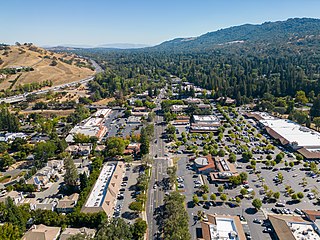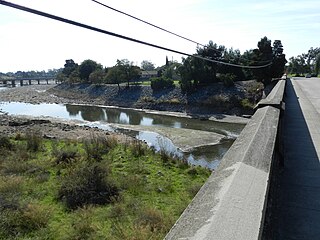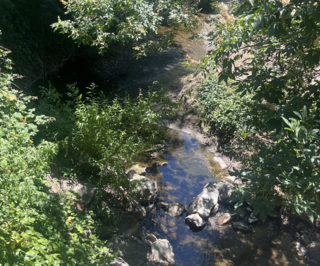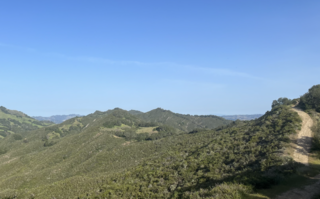
Contra Costa County is a county located in the U.S. state of California, in the East Bay of the San Francisco Bay Area. As of the 2020 United States Census, the population was 1,165,927. The county seat is Martinez. It occupies the northern portion of the East Bay region of the San Francisco Bay Area and is primarily suburban. The county's name refers to its position on the other side of the bay from San Francisco. Contra Costa County is included in the San Francisco–Oakland–Berkeley, CA Metropolitan Statistical Area.

Alamo is an unincorporated community and census-designated place (CDP) in Contra Costa County, California, in the United States. It is a suburb located in the San Francisco Bay Area's East Bay region, approximately 28 miles (45 km) east of San Francisco. Alamo is equidistant from the city of Walnut Creek and the incorporated town of Danville. As of the 2020 census, the population was 15,314.

Walnut Creek is a city in Contra Costa County, California, United States, located in the East Bay region of the San Francisco Bay Area, about 16 miles east of the city of Oakland. Walnut Creek has a total population of 70,127 per the 2020 census, is located at the junction of the highways from Sacramento and San Jose (I-680) and San Francisco/Oakland (SR-24), and is accessible by BART. The city shares its borders with Clayton, Lafayette, Alamo, Pleasant Hill, and Concord.
The San Ramon Valley is a valley and region in Contra Costa County and Alameda County, in the East Bay region of the San Francisco Bay Area in northern California.

Alameda Creek is a large perennial stream in the San Francisco Bay Area. The creek runs for 45 miles (72 km) from a lake northeast of Packard Ridge to the eastern shore of San Francisco Bay by way of Niles Canyon and a flood control channel. Along its course, Alameda Creek provides wildlife habitat, water supply, a conduit for flood waters, opportunities for recreation, and a host of aesthetic and environmental values. The creek and three major reservoirs in the watershed are used as water supply by the San Francisco Public Utilities Commission, Alameda County Water District and Zone 7 Water Agency. Within the watershed can be found some of the highest peaks and tallest waterfall in the East Bay, over a dozen regional parks, and notable natural landmarks such as the cascades at Little Yosemite and the wildflower-strewn grasslands and oak savannahs of the Sunol Regional Wilderness. After an absence of half a century, ocean-run steelhead trout are able to return to Alameda Creek to mingle with remnant rainbow trout populations. Completion of a series of dam removal and fish passage projects, along with improved stream flows for cold-water fish and planned habitat restoration, enable steelhead trout and Chinook salmon to access up to 20 miles (32 km) of spawning and rearing habitat in Alameda Creek and its tributaries. The first juvenile trout migrating downstream from the upper watershed through lower Alameda Creek toward San Francisco Bay was detected and documented in April 2023.

John Albert Nejedly was a district attorney and Republican state senator in California who represented Contra Costa County from 1958 to 1980.

Pacheco Creek is a 3.4-mile-long (5.5 km) waterway in central Contra Costa County, California, United States. It empties into Suisun Bay. It is formed by the intersection of Walnut Creek, Grayson Creek and Pine Creek.

Rancho Arroyo de Las Nueces y Bolbones was a 17,782-acre (71.96 km2) Mexican land grant in present-day Contra Costa County, California given in 1834 by Governor José Figueroa to Juana Sanchez de Pacheco.
Grayson Creek is a stream in Contra Costa County in northern California that flows northeasterly 7.4 miles (11.9 km) from its origin in Briones Regional Park to Pacheco Slough four miles east of Martinez. Pacheco Slough, in turn, connects to Suisun Bay. The Grayson Creek subwatershed is part of the Walnut Creek watershed and includes the cities of Pleasant Hill and Pacheco, California.
The Saklan are a tribe of the Native American Miwok community, based just south of San Pablo and Suisun Bays, in Contra Costa County, California. Their historical tribal lands ranged from Moraga, to San Leandro Creek, to Lafayette.

Las Trampas Creek is a 12.37 mile long north-east flowing stream in Contra Costa County, California. Its watershed comprises an area of 17,238 acres. It's mean daily flow is approximately 15.4 cfs.

Grizzly Creek is a 3.2-mile-long northwest-flowing perennial stream in Contra Costa County, California. It is a major tributary of Las Trampas Creek, which is part of the larger Walnut Creek watershed, which in turn drains into Suisun Bay.

Las Trampas Peak is a 1,827 ft (557 m) peak in the Inner Coast Ranges in western Contra Costa County, California, in the San Francisco Bay Area.

Rocky Ridge is a 2,020 ft (620 m) ridge in the Inner Coast Ranges in western Contra Costa County, California, in the San Francisco Bay Area. Being the second-highest mountain in the county, it is visible from much of the surrounding area. The ridge is a very prominent feature in the geography of the towns of Lafayette, Moraga and Orinda, California.

Lafayette Creek is a 3.78 mi (6.08 km) long creek in Contra Costa County, California in the San Francisco Bay Area. It is a tributary of Las Trampas Creek.

Tice Creek is a minor creek in Contra Costa County, California in the San Francisco Bay Area. It is approximately 4.1 miles (6.6 km) long. It is a tributary of Las Trampas Creek, which itself is a major tributary to Walnut Creek which in turn drains into Suisun Bay. The name comes from the surname of a settler family who settled in the Tice valley.

Bollinger Canyon Creek is an approximately 6.72-mile-long stream in Contra Costa County, California in the San Francisco Bay Area. It is a tributary of San Ramon Creek which is part of the Walnut Creek watershed. The creek derives its name from the surname of a family who settled in the area in the 19th century.

Buckhorn Creek is a 2.1 mile long creek in Contra Costa County, California, in the San Francisco Bay Area. It gets its name from the Buckhorn family who settled on the creek in the late 19th century.

Las Trampas Ridge is an 1,827 ft ridge in western Contra Costa County, California, in the San Francisco Bay Area. It comprises the western side of the San Ramon Valley.
Mount Diablo Creek is a 14.3-mile-long (23.0 km) northwest-flowing stream originating on the north flank of Mount Diablo. Its dozen small tributaries gather near Clayton before flowing through Concord and the Concord Naval Weapons Station, ultimately ending in tidelands on the southern shore of Suisun Bay in Contra Costa County. If the Concord Naval Weapons Station is converted to protected wildlands, Mount Diablo Creek may serve as the last wildlife corridor for black-tailed deer, tule elk, and other mammals from Mount Diablo to Suisun Bay.


















